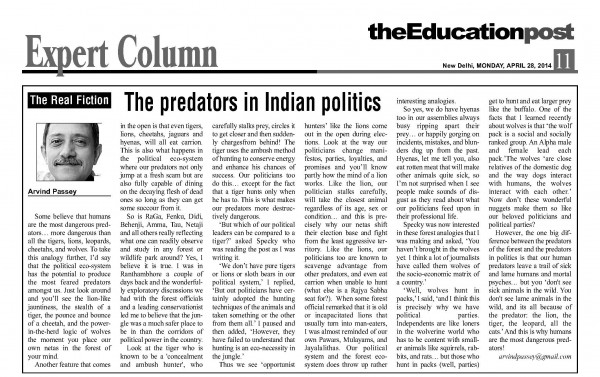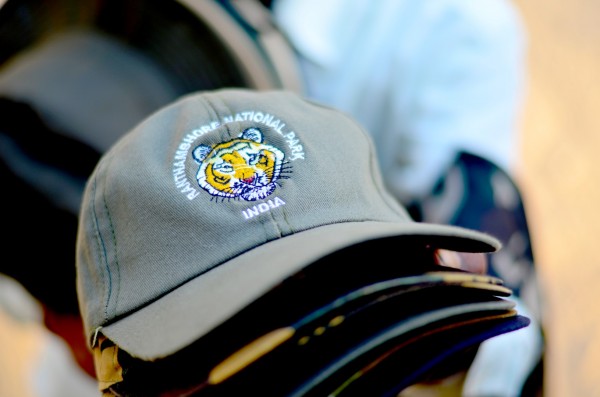Some believe that humans are the most dangerous predators… more dangerous than all the tigers, lions, leopards, cheetahs, and wolves. To take this analogy further, I’d say that the political eco-system has the potential to produce the most feared predators amongst us. Just look around and you’ll see the lion-like jauntiness, the stealth of a tiger, the pounce and bounce of a cheetah, and the power-in-the-herd logic of wolves the moment you place our own netas in the forest of your mind.
Another feature that comes in the open is that even tigers, lions, cheetahs, jaguars and hyenas, will all eat carrion. This is also what happens in the political eco-system where our predators not only jump at a fresh scam but are also fully capable of dining on the decaying flesh of dead ones so long as they can get some succour from it.
So is RaGa, Fenku, Didi, Behenji, Amma, Tau, Netaji and all others really reflecting what one can readily observe and study in any forest or wildlife park around? Yes, I believe it is true. I was in Ranthambhore a couple of days back and the wonderfully exploratory discussions we had with the forest officials and a leading conservationist led me to believe that the jungle was a much safer place to be in than the corridors of political power in the country.
Look at the tiger who is known to be a ‘concealment and ambush hunter’, who carefully stalks prey, circles it to get closer and then suddenly charges from behind! The tiger uses the ambush method of hunting to conserve energy and enhance his chances of success. Our politicians too do this… except for the fact that a tiger hunts only when he has to. This is what makes our predators more destructively dangerous.
‘But which of our political leaders can be compared to a tiger?’ asked Specky who was reading the post as I was writing it.
‘We don’t have pure tigers or lions or sloth bears in our political system,’ I replied, ‘But out politicians have certainly adopted the hunting techniques of the animals and taken something or the other from them all.’ I paused and then added, ‘However, they have failed to understand that hunting is an eco-necessity in the jungle.’
Thus we see ‘opportunist hunters’ like the lions come out in the open during elections. Look at the way our politicians change manifestos, parties, loyalties, and promises and you’ll know partly how the mind of a lion works. Like the lion, our politician stalks carefully, will take the closest animal regardless of its age, sex or condition… and this is precisely why our netas shift their election base and fight from the least aggressive territory. Like the lions, our politicians too are known to scavenge advantage from other predators, and even eat carrion when unable to hunt (what else is a Rajya Sabha seat for?). When some forest official remarked that it is old or incapacitated lions that usually turn into man-eaters, I was almost reminded of our own Pawars, Mulayams, and Jayalalithas. Our political system and the forest eco-system does throw up rather interesting analogies.
So yes, we do have hyenas too in our assemblies always busy ripping apart their prey… or happily gorging on incidents, mistakes, and blunders dug up from the past. Hyenas, let me tell you, also eat rotten meat that will make other animals quite sick, so I’m not surprised when I see people make sounds of disgust as they read about what our politicians feed upon in their professional life.
Specky was now interested in these forest analogies that I was making and asked, ‘You haven’t brought in the wolves yet. I think a lot of journalists have called them wolves of the socio-economic matrix of a country.’
‘Well, wolves hunt in packs,’ I said, ‘and I think this is precisely why we have political parties. Independents are like loners in the wolverine world who has to be content with smaller animals like squirrels, rabbits, and rats… but those who hunt in packs (well, parties) get to hunt and eat larger prey like the buffalo. One of the facts that I learned recently about wolves is that ‘the wolf pack is a social and socially ranked group. An Alpha male and female lead each pack.’ The wolves ‘are close relatives of the domestic dog and the way dogs interact with humans, the wolves interact with each other.’ Now don’t these wonderful nuggets make them so like our beloved politicians and political parties?
However, the one big difference between the predators of the forest and the predators in politics is that our human predators leave a trail of sick and lame humans and mortal psyches… but you ‘don’t see sick animals in the wild. You don’t see lame animals in the wild, and its all because of the predator: the lion, the tiger, the leopard, all the cats.’ And this is why humans are the most dangerous predators!
Note:
#saveourtigers project where Aircel and WCT are actively involved… helped us come closer to conservation in Ranthambhore!
Aircel on Facebook
#saveourtiger on Facebook
Wildlife Conservation Trust
Save Our Tigers Initiative on the web
Arvind Passey
28 April 2014
Published in ‘The Education Post’ dated 28 April 2014…













1 comments
Each species is a masterpiece | Passey.info says:
Jul 20, 2015
[…] can be a thousand reasons that I can site for saving our tiger… but let me pamper the romantic within me and just say that I would not like to miss watching a […]